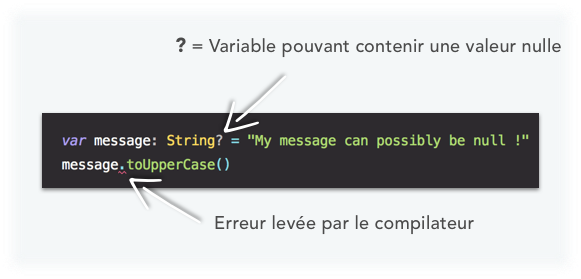

Both are compiled into Ljava/lang/String. LOCALVARIABLE canBeNull Ljava/lang/String L1 元 0Īs we can see, at the bytecode level, there is no difference between a nullable type and a non-nullable type.

LOCALVARIABLE nonNull Ljava/lang/String L2 元 1 Val nonNull: String = null // compiler error Below is the code to define a String and a String? val canBeNull: String? = null We will start with the simplest case, null safety with a local nullable variable. The same principle can be applied to any other type. But at the end of the day, Kotlin code is still compiled into bytecode and runs on the JVM.Īs an example, today we will find out how Kotlin distinguishes between the String and String? types when the JVM only knows of Ljava/lang/String. Kotlin distinguishes between references that can hold null (nullable types) and references that cannot (non-nullable types). One of Kotlin’s improvements over Java is null safety. I think it is worth giving Kotlin a try if only to expand your programming horizons.Note: phiên bản Tiếng Việt của bài này ở link dưới. I hope reading this article will help you leverage your Optional experience to quickly learn Kotlin's null safety features. In our case, we also need to use the safe call operator to skip the calculation for null values: val lengthKotlin: Int? = kotlinNullable?.let Kotlin provides the built-in method let, which we can invoke on any object. If the transformation cannot be performed by a simple method call, then Optional’s map method is happy to take a lambda as well. Val lengthJava: Optional = javaNullable.map(String::length) To do the same in Kotlin, we can use safe call operator (?.) as demonstrated below: val lengthKotlin: Int? = kotlinNullable?.length To transform the value inside Optional using the inner value’s method we can apply a method reference to map. Map Using The Method of The Inner Value’s Type

Val javaNullable: Optional = Optional.ofNullable("Java way, can be null as well”) The code below shows both approaches: val kotlinNullable: String? = "Kotlin way, this can be null" In Kotlin, there is no additional overhead. Optional usage requires creating a new object for the wrapper every time some value is wrapped or transformed to another type - with the exclusion of when the Optional is empty (singleton empty Optional is used). The code in the examples is written in Kotlin because the language has all the JDK classes available. In this article, I will try to map methods of Java’s Optional to Kotlin’s similar, scattered language features and built-in functions.


 0 kommentar(er)
0 kommentar(er)
